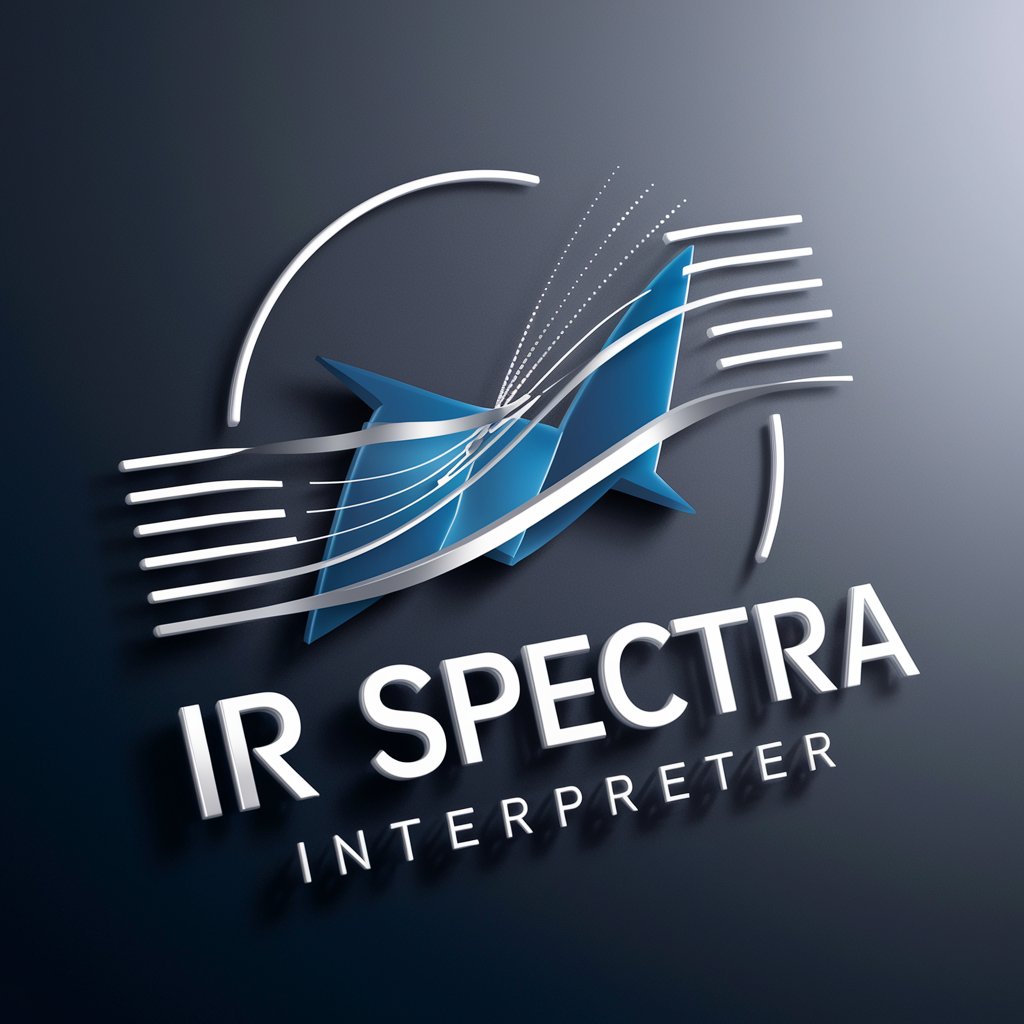
IR Spectra Interpreter - IR Spectrum Analysis

Welcome! Ready to decode your IR spectra?
Deciphering spectra with AI precision
Upload your IR spectrum and I'll help you interpret the key signals.
What compound are you analyzing? Share your spectrum for detailed insights.
Need help with your IR spectra analysis? Provide your spectrum for interpretation.
Struggling with your IR spectrum? Let me break down the key peaks for you.
Get Embed Code
Introduction to IR Spectra Interpreter
IR Spectra Interpreter is a specialized tool designed to analyze infrared (IR) spectra, particularly focusing on interpreting key signals, especially outside the fingerprint region, which is above 1500 cm^-1. The primary goal of this tool is to provide concise, informative interpretations by highlighting important peaks and suggesting potential compounds based on their characteristic IR signals. For instance, if a user uploads an IR spectrum showing a peak at 1700 cm^-1, IR Spectra Interpreter would identify this as a possible carbonyl group (C=O) stretching vibration, indicating the presence of ketones, aldehydes, carboxylic acids, or esters. This tool is designed to enhance users' understanding of IR spectra by offering direct educational responses, aiding in the identification and analysis of organic compounds. It prompts users to upload their spectra for a more accurate analysis and formats the results in a table, listing wavenumbers alongside their corresponding signal causes, such as [1500 cm^-1] [C=C stretching vibrations in the aromatic ring], thus facilitating a deeper comprehension of the molecular structure and functionalities present in the sample. Powered by ChatGPT-4o。

Main Functions of IR Spectra Interpreter
Peak Identification
Example
Identifying a peak at 3300 cm^-1 as indicative of O-H stretching in alcohols or carboxylic acids.
Scenario
When a researcher analyzing an unknown organic compound observes a strong, broad signal around 3300 cm^-1, they can use IR Spectra Interpreter to confirm the presence of hydroxyl groups, aiding in narrowing down the compound's identity.
Compound Suggestion
Example
Suggesting the presence of an ester group based on a peak at 1740 cm^-1.
Scenario
In the case of a chemist trying to verify the product of an esterification reaction, a sharp signal around 1740 cm^-1 would be identified by the tool as characteristic of ester C=O stretching, confirming the reaction's success.
Educational Guidance
Example
Explaining the significance of peaks within the fingerprint region for compound identification.
Scenario
A student learning about IR spectroscopy might not understand the complexity of the fingerprint region. IR Spectra Interpreter can elucidate the importance of this region for distinguishing between similar compounds, enhancing their understanding of spectroscopic analysis.
Ideal Users of IR Spectra Interpreter Services
Academic Researchers
Researchers working in organic chemistry or materials science who frequently need to identify or verify compounds. They benefit from the tool's ability to interpret complex spectra, aiding in their research and publication efforts.
Chemistry Students
Undergraduate and graduate students taking courses in organic chemistry, analytical chemistry, or related fields. The tool serves as an educational resource, helping them to better understand IR spectroscopy and the structure of organic molecules.
Industrial Chemists
Professionals in pharmaceuticals, polymers, and chemicals manufacturing who use IR spectroscopy for quality control and R&D. The tool helps in quickly identifying compounds and potential impurities, ensuring product quality.

How to Use IR Spectra Interpreter
Start Your Journey
Access the tool for free without needing to log in or have a ChatGPT Plus subscription by visiting the designated website.
Upload Your Spectrum
Prepare and upload the IR spectrum file you wish to analyze. Ensure it's in a supported format for accurate interpretation.
Specify Compound Information
Provide any known details about the compound or sample you're analyzing to enhance the accuracy of the interpretation.
Review the Analysis
Examine the generated report which includes key signals, potential compounds, and interpretations of the spectrum.
Utilize the Insights
Apply the insights from the analysis for your research, academic writing, or to guide further experimental work.
Try other advanced and practical GPTs
Copper Bars
Empowering your copper investments with AI

Edu Sprouts_Beta Version
Crafting Educational Journeys with AI

ITlawyer
Empowering Legal Decisions with AI

AMI’s Slogan Spark
Crafting catchy slogans with AI power

Business Partner
AI-powered partnership strategy advisor

Lifehack Guru
Empowering your decisions with AI-powered insights.

Scandal
Uncover the truth with AI-powered analysis

GPT Business Intelligence
Unleashing AI Power for Strategic Business Decisions

Gas Generator
Powering Your Decisions with AI

Questions
Unlock insights with AI-powered inquiries

Alumni
Connect, Network, and Reunite with Alumni AI

Professeur CellBio
AI-powered cell biology learning assistant

Frequently Asked Questions about IR Spectra Interpreter
What formats of spectra files can I upload?
IR Spectra Interpreter supports various common spectrum file formats, including but not limited to .spc, .dx, and .jdx, ensuring compatibility with most spectroscopy software outputs.
Can I use IR Spectra Interpreter for complex mixtures?
Yes, while IR Spectra Interpreter is optimized for identifying key signals and potential compounds, complex mixtures may require additional context or details for accurate interpretation.
How accurate is the tool's interpretation of spectra?
The tool provides highly accurate interpretations based on the input spectrum and known compound details. Accuracy improves with the quality of the provided spectrum and information.
Is there a limit to the number of spectra I can analyze?
Currently, there is no hard limit. However, for optimal performance and to ensure resource availability for all users, consider analyzing your most critical spectra.
Can IR Spectra Interpreter suggest the next steps after analysis?
Yes, besides identifying key signals, the tool can suggest follow-up experiments or additional tests to confirm the presence of suspected compounds or to further explore the sample's properties.